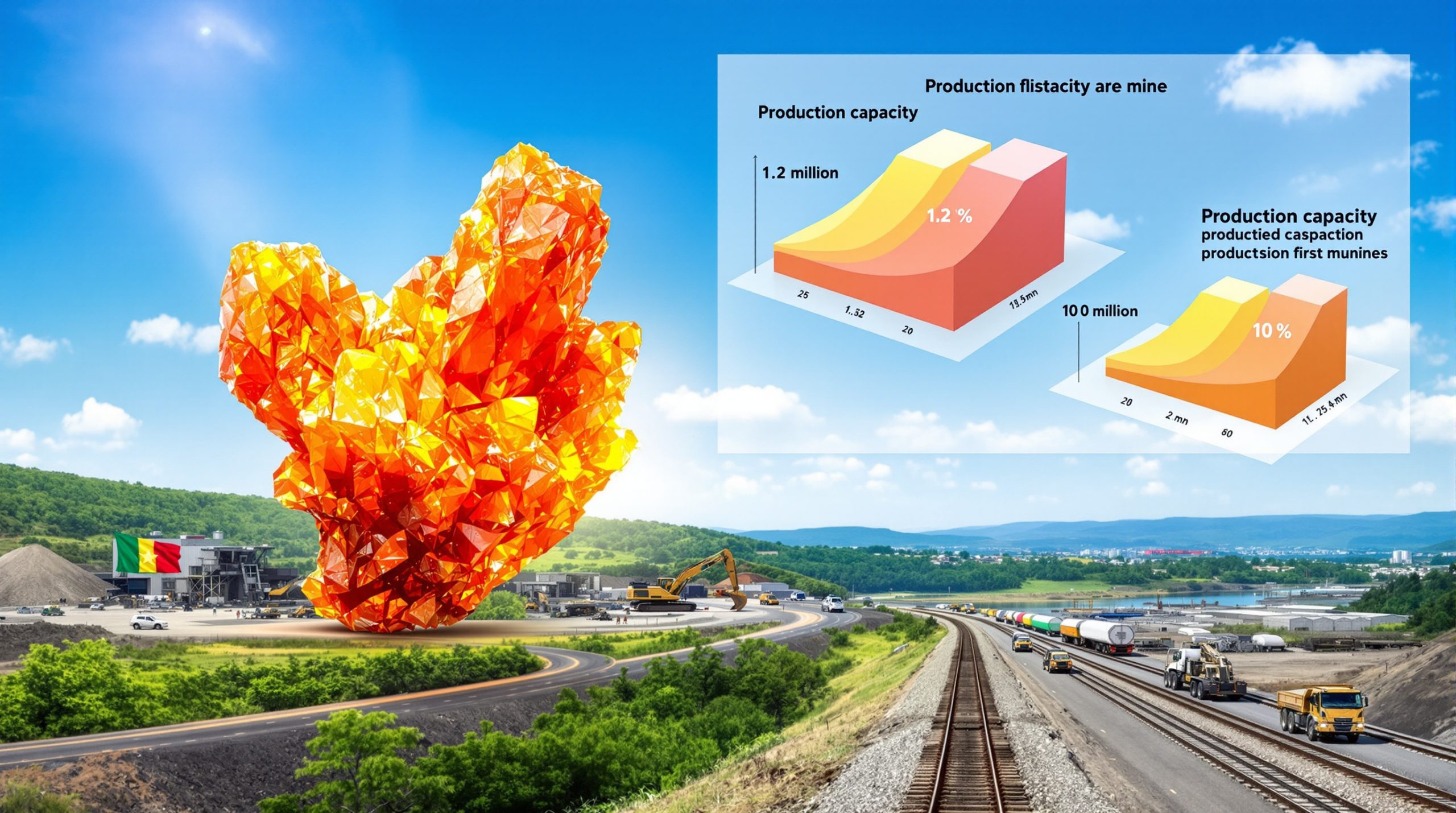Understanding the Wyloo-Hastings Yangibana Joint Venture: Strategic Implications for Australia's Rare Earths Sector
The Wyloo-Hastings Yangibana joint venture represents a significant development in Australia's rare earths industry, combining technical expertise with financial strength to advance one of the nation's most promising critical minerals projects. This strategic partnership, formalized in September 2024, positions Australia to strengthen its role in global rare earth supply chains while addressing growing demand for elements crucial to renewable energy technologies and advanced electronics.
What is the Yangibana Rare Earths Project?
The Yangibana project stands as one of Australia's most advanced rare earths developments, strategically positioned to supply critical materials for the global energy transition. Located in Western Australia's remote Gascoyne region approximately 270km northeast of Carnarvon, this world-class deposit contains exceptional concentrations of the most commercially valuable rare earth elements.
Strategic Location and Resource Profile
Yangibana's resource estimate includes approximately 21.0 million tonnes of ore at 1.12% total rare earth oxides, according to Hastings Technology Metals' February 2024 ASX announcement. What makes this deposit particularly valuable is its high concentration of neodymium (Nd) and praseodymium (Pr), which comprise about 20% of the total rare earth content – significantly higher than most global deposits.
The project also contains valuable niobium resources alongside the rare earth elements, with niobium representing approximately 15% of the project's overall economic value. This diversification provides additional revenue potential beyond the core rare earth focus.
Yangibana's processing infrastructure has been designed to produce Mixed Rare Earth Carbonate (MREC), a concentrated intermediate product that can be further processed into separated rare earth oxides. The MREC production facility is designed with a capacity of 15,000 tonnes per annum, according to Hastings' definitive feasibility study insights.
Development Status and Timeline
Approximately A$226 million has already been invested in Phase 1 and 2 development, representing significant progress toward bringing the project online. The original production timeline targeted commencement in the second half of 2024, though current status updates are required to confirm the latest schedule.
Based on current resource assessments, Yangibana has an estimated 17-year mine life, providing long-term supply security for critical minerals essential to modern technologies. The project's infrastructure development, including processing facilities, has been advancing steadily, with much of the groundwork already completed.
Yangibana represents a key component in Australia's critical minerals reserve strategy, aligning with national objectives to diversify global supply chains for materials essential to defense, renewable energy, and high-tech manufacturing sectors.
How Did the Wyloo-Hastings Partnership Form?
The formation of this strategic partnership followed months of negotiations and due diligence, resulting in a structure designed to leverage each partner's strengths while addressing capital constraints.
Initial Announcement and Structure
The partnership was first announced in May 2024, structured as an unincorporated joint venture (UJV) between Wyloo Gascoyne and Hastings Technology Metals. Under the terms of the agreement, Wyloo acquired a 60% ownership stake and management rights, while Hastings retained a 40% ownership interest in the project.
This ownership structure follows successful models used by other Australian resource companies, including the Northern Minerals-Iluka joint venture for rare earths development and the Lynas-Blue Line partnership for U.S. rare earth processing.
The regulatory approval process was completed in September 2024, following shareholder approval at an extraordinary general meeting held on July 30, 2024. This milestone marked the official formation of the joint venture and allowed operational transition to begin.
Financial Arrangements
A key component of the deal involved the cancellation of Hastings' exchangeable notes worth A$135 million, which were originally due to mature in October 2025. This debt elimination significantly improved Hastings' balance sheet and financial flexibility.
The transaction structure substantially reduced capital exposure for Hastings shareholders while maintaining significant ownership in the project's future success. Importantly, it provides a pathway to production without additional shareholder dilution that might otherwise have been necessary to fund the substantial capital requirements of mine development.
As Hastings CEO Vince Catania noted in the company's ASX announcement, the partnership "provides a clear, credible and significantly de-risked pathway to production" and "validates the world-class nature of the Yangibana deposit."
What Makes This Joint Venture Strategically Important?
The Wyloo-Hastings partnership carries strategic implications that extend beyond the companies involved, addressing national and global challenges in critical mineral supply chains.
Critical Minerals Supply Chain Security
China currently controls approximately 60% of global rare earth mining and 85% of processing capacity, according to the U.S. Geological Survey's Mineral Commodity Summaries 2024. This concentration creates vulnerability in supply chains for materials essential to defense, electronics, and renewable energy technologies.
The Yangibana project strengthens Australia's position in the global rare earths market as an alternative supplier, helping to diversify and secure international supply chains. Australia holds the world's second-largest rare earth reserves distribution at 4.2 million tonnes, according to Geoscience Australia's Critical Minerals Prospectivity report from 2023, positioning the country as a natural alternative supplier.
The project supports sovereign capability in strategic resource development, aligning with Australia's national critical minerals strategy objectives and recent policy initiatives designed to reduce dependence on dominant international suppliers.
Technological Applications of Project Output
Neodymium and praseodymium are crucial components in the manufacturing of permanent magnets, which power everything from electric vehicles to wind turbines. These high-strength magnets represent the fastest-growing application for rare earth elements.
According to the International Energy Agency's Critical Minerals Market Review 2023, electric vehicle motors typically require 1-2kg of NdPr per vehicle, while wind turbines use 200-600kg of NdPr per MW of capacity. With global EV sales reaching 14 million units in 2023 and renewable energy deployment accelerating, demand for these elements is projected to grow substantially.
The global permanent magnet market is expected to reach $35.6 billion by 2030, growing at a compound annual growth rate of 8.2%, according to Fortune Business Insights' Permanent Magnets Market Report. This growth trajectory underscores the long-term value proposition of the Yangibana project.
Beyond renewable energy applications, NdPr magnets are essential components in advanced electronics, defense technologies, and industrial equipment, creating multiple market opportunities for the project's output.
Who Are the Key Players in This Partnership?
Understanding the capabilities and strategic positions of both partners provides insight into the joint venture's potential for success.
Wyloo's Strategic Position
As the 60% stakeholder, Wyloo takes operational control of the Yangibana project, bringing significant technical and financial resources to accelerate development. Connected to the broader Tattarang investment group, Wyloo has access to substantial capital resources and mining expertise.
Wyloo CEO Luca Giacovazzi emphasized the project's unique advantages, stating that "Yangibana has the shortest pathway to commercial production and requires the least amount of capital of any other Australian rare earths project." This assessment suggests confidence in the project's economic viability compared to competing developments.
The company's commitment to developing Australia's critical minerals sector aligns with its broader investment strategy focusing on materials essential to the global energy transition. Wyloo's operational expertise positions it to potentially accelerate the project development timeline and optimize production methods.
Hastings' Continuing Role
While transferring operational control to Wyloo, Hastings maintains a 40% project ownership stake, retaining significant exposure to Yangibana's future success. This structure allows Hastings to benefit from the project while reducing its capital requirements and risk exposure.
The partnership frees Hastings to focus on other development opportunities while leveraging Wyloo's expertise and financial resources. Shareholder approval for the transaction was secured with strong support at the July 2024 extraordinary general meeting, indicating investor confidence in the strategic direction.
Hastings' ongoing involvement ensures continuity of project knowledge and maintains the company's position in Australia's emerging rare earths sector. The company's market capitalization of approximately A$180 million (as of September 2025) reflects its reduced but still significant stake in the Yangibana project.
What Operational Changes Will the Joint Venture Bring?
The transition to joint venture operation brings significant changes to project management and development strategy, with implications for timeline and execution.
Management Structure Transformation
Under the new arrangement, Wyloo assumes project management responsibilities, implementing a new technical development approach based on its experience in mining operations. This transition streamlines decision-making processes through clear delineation of management authority.
The joint venture structure enhances funding capabilities for project advancement, combining Wyloo's financial resources with Hastings' reduced but still significant capital commitment. A coordinated supply chain strategy implementation will be essential as the project moves toward production, addressing both upstream suppliers and downstream customers.
The management transition requires integration of team members from both organizations to ensure knowledge transfer and operational continuity. While change management always presents challenges, the complementary skills of both organizations create potential for enhanced project execution.
Development Acceleration Strategy
According to Wyloo, Yangibana offers the shortest pathway to commercial production among Australian rare earths projects, positioning it to potentially be the next domestic producer after Lynas Rare Earths. The project's reduced capital requirements compared to competing projects make it more financeable in challenging capital markets.
Technical expertise from both companies will be applied to optimize production methods and improve operational efficiency. The streamlined approval and development processes under joint management could accelerate the project timeline, though specific updates to the original 2024 production target are required.
The focus on rapid transition from development to production aligns with market demand projections for rare earth elements, potentially allowing the project to capture premium pricing during supply constraints. The joint venture's strategy emphasizes reaching production stage efficiently rather than expanding resource size, reflecting a commercial rather than exploratory focus.
How Does This Affect Australia's Rare Earths Industry?
Beyond company-specific impacts, the joint venture carries broader implications for Australia's position in global rare earths markets and domestic economic development.
Market Positioning Impact
The Wyloo-Hastings partnership strengthens Australia's position as an alternative rare earths supplier to China, potentially increasing the country's market share beyond current levels. Australia's rare earth exports were valued at A$347 million in 2022-23 according to the Australian Bureau of Statistics, with substantial growth potential as new projects come online.
The joint venture creates competitive advantages through synergies between Hastings' project development progress and Wyloo's operational expertise and financial backing. This positions Yangibana as a key player in emerging supply chains for critical minerals.
The project also establishes a foundation for potential downstream processing opportunities, moving beyond raw material production into higher-value activities. This vertical integration potential aligns with Australia's strategy to capture more value from its natural resources.
Economic and Employment Benefits
The mining sector employed 273,900 people in Australia as of August 2024, according to the Australian Bureau of Statistics' Labour Force Survey. Yangibana will contribute additional jobs throughout the Gascoyne region, both directly at the mine site and indirectly through support services and suppliers.
Skills development in advanced mining and processing technologies will enhance the regional workforce's capabilities and earning potential. The project supports economic diversification in Western Australia, reducing dependence on traditional commodities like iron ore.
Supply chain development opportunities extend beyond the mine site to include transportation, processing, and technical services. The project's 17-year mine life creates long-term export potential for high-value products, generating sustainable economic benefits.
What Challenges Must the Joint Venture Navigate?
Despite its promising outlook, the Yangibana project faces several technical, market, and operational challenges that will require careful management.
Technical Development Considerations
Rare earth processing involves complex chemical procedures for extraction and separation of individual elements. Water usage requirements typically range from 8-15 cubic meters per tonne processed, according to the Australian Government Department of Agriculture, Water and Environment, presenting logistical challenges in the arid Gascoyne region.
Environmental management in sensitive regions requires careful planning and monitoring to meet regulatory requirements and community expectations. Radioactive waste management protocols under Australian Radiation Protection and Nuclear Safety Agency guidelines must be rigorously implemented, as rare earth deposits often contain naturally occurring radioactive materials.
The remote location creates logistics challenges for transportation of equipment, supplies, and finished products. Optimizing recovery rates and product quality will be essential to maximize project economics and meet customer specifications.
Market and Competitive Factors
Price volatility represents a significant challenge, with neodymium oxide prices ranging from $68-95/kg in 2023 and praseodymium oxide fluctuating between $72-108/kg in the same period, according to Metal Bulletin price assessments. This volatility complicates financial planning and return calculations.
International competition from established producers, particularly in China, creates pricing pressure and market access challenges. Evolving regulatory frameworks for critical minerals in both Australia and customer countries can impact export requirements and compliance costs.
Securing long-term offtake agreements will be crucial to project economics, providing revenue certainty against development costs. The joint venture must balance production costs against market prices to ensure sustainable profitability, particularly during potential market downturns.
How Will This Impact Investors and Shareholders?
The joint venture structure creates specific financial implications for both companies and their shareholders, with distinct risk-reward profiles.
Financial Implications for Hastings
The significant debt reduction through note cancellation worth A$135 million substantially improves Hastings' financial position and reduces financial stress. The reduced capital expenditure requirements allow Hastings to allocate resources to other opportunities while maintaining exposure to Yangibana's potential.
The company maintains exposure to project upside potential through its 40% stake, balanced with reduced downside risk from lower capital commitment. The improved balance sheet position enhances Hastings' ability to access capital markets for other ventures if needed.
For Hastings shareholders, the partnership provides a clearer pathway to revenue generation without further dilution that might have been necessary to fully fund the project independently. This balance of reduced risk while maintaining significant upside potential has been viewed favorably by the market.
Value Creation Mechanisms
The de-risked development pathway improves project viability by addressing both technical and financial challenges that often derail mining projects. Enhanced project credibility through the partnership with a well-resourced partner improves market perception and potential customer confidence.
Access to broader technical and operational expertise from both organizations improves execution capability and problem-solving capacity. The improved project economics through shared investment reduce the capital burden on each partner while maintaining significant ownership stakes.
For investors, the potential for accelerated returns through faster development and production represents an attractive value proposition compared to competing projects with longer timelines to cash flow.
What Are the Next Steps for the Yangibana Project?
With the joint venture now established, attention turns to execution and the path to production.
Immediate Development Priorities
Finalization of remaining technical studies and engineering designs will be critical to moving toward construction and commissioning. Optimization of processing methodologies may identify improvements to recovery rates and operating costs from the original plans.
Completion of infrastructure development, including power, water, and site facilities, represents substantial work remaining before production can commence. Securing any remaining permits and approvals is essential to avoid regulatory delays that could impact the timeline.
Implementation of joint operational protocols and integration of management systems from both companies will be necessary for effective collaboration. A comprehensive project schedule with clear milestones and accountability will be essential to tracking progress.
Long-term Strategic Vision
Establishing sustainable production operations with consistent output quality and volume will be the initial operational focus. Beyond initial production, exploring downstream processing opportunities could increase value-added activities and product margins.
Investigating resource expansion potential through additional exploration could extend mine life beyond the current 17-year projection. Developing market relationships with end-users in renewable energy, electronics, and defense sectors will be crucial to securing premium pricing and steady demand.
The project's contribution to Australia's critical minerals strategy extends beyond commercial considerations to national interest in secure supply chains. Success at Yangibana could serve as a model for development of other critical mineral resources throughout Australia and foster additional mining JV consolidation trends in the sector.
FAQ: Wyloo-Hastings Yangibana Joint Venture
What makes the Yangibana project unique among rare earths deposits?
Yangibana contains exceptionally high concentrations of neodymium and praseodymium, comprising about 20% of total rare earth content compared to global averages of 10-15%. These elements command the highest prices among rare earths due to their essential role in permanent magnets for electric vehicles and renewable energy technologies.
How does this joint venture affect Australia's position in global rare earths markets?
The partnership strengthens Australia's role as an alternative supplier to China, which currently dominates global production. By bringing Yangibana into production, Australia increases its rare earth export capacity and provides supply chain diversification for international customers seeking reliable sources of critical minerals.
What economic benefits might the project bring to Western Australia?
Beyond direct employment at the mine and processing facilities, Yangibana will create opportunities throughout the supply chain, from logistics and services to potential downstream processing industries. The project's 17-year mine life provides long-term employment security and economic development for the Gascoyne region, a remote area that benefits significantly from resource development.
How does the joint venture structure benefit both companies?
Wyloo gains operational control of a world-class rare earths project with advanced development status, supporting its strategic focus on critical minerals. Hastings reduces its capital exposure while maintaining significant ownership, eliminating substantial debt obligations, and clearing a path to production without further shareholder dilution.
What timeline can be expected for production to commence?
The original target for production was the second half of 2024, though updated timelines following the joint venture formation should be consulted for current projections. With approximately A$226 million already invested and significant development work completed, the project is well-advanced compared to other Australian rare earth developments.
Want to Find the Next Mining Discovery Before the Market?
Discover how ASX mineral discoveries can deliver exceptional returns by exploring Discovery Alert's dedicated discoveries page, where the proprietary Discovery IQ model helps investors identify high-potential opportunities before the broader market. Begin your 30-day free trial today to receive real-time alerts on significant discoveries like the emerging rare earths developments discussed in this article.




